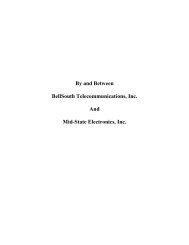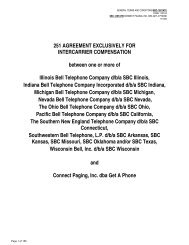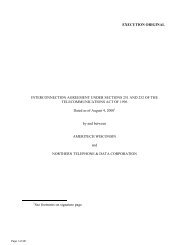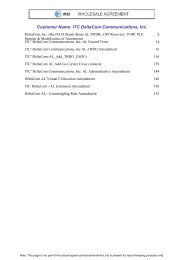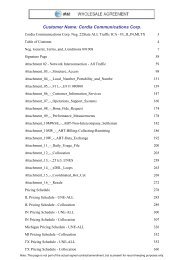CELLULAR/PCS INTERCONNECTION ... - AT&T Clec Online
CELLULAR/PCS INTERCONNECTION ... - AT&T Clec Online
CELLULAR/PCS INTERCONNECTION ... - AT&T Clec Online
You also want an ePaper? Increase the reach of your titles
YUMPU automatically turns print PDFs into web optimized ePapers that Google loves.
Page 178 of 250<br />
APPENDIX WIRELESS PHYSICAL COLLOCATION/AT&T-13STATE<br />
PAGE 53 OF 62<br />
AT&T-13STATE/NEW CINGULAR WIRLESS <strong>PCS</strong>, LLC<br />
020106<br />
chooses to disconnect and remove the power cable feed from a power arrangement (A&B feed),<br />
then the charges referenced in Section 19.8 will apply. If the Wireless Collocator has multiple<br />
power arrangements (A&B feed) where they can request both a fuse reduction and a power cable<br />
removal for one Physical Collocation Arrangement [i.e. reduce one power arrangement from fifty<br />
(50) amps (A&B feed) to twenty (20) amps (A&B feed) and remove the power cable from a second<br />
power arrangement from fifty (50) amps (A&B feed) to 0 amps (A&B feed)], then the project<br />
management fee for power cable removal referenced in Section 18.8 will apply in addition to the<br />
individual charges referenced in either Section 19.8, or 19.9 associated with the overall power<br />
reduction request.<br />
19.4.6 For any power reduction request (one which involves either a disconnect and removal, re-fusing<br />
only, or a combination of the two), the Wireless Collocator must submit an augment application for<br />
this request along with the appropriate application and project management fees referenced in<br />
Section 19.8. The same augment intervals that are outlined in this Appendix for adding power will<br />
apply to power reduction requests.<br />
19.5 Interconnection Termination Reduction<br />
19.5.1 The Wireless Collocator may request a reduction of the existing amount of interconnection<br />
terminations that service a Physical Collocation Arrangement. The Wireless Collocator shall<br />
submit an augment application in order to process this request. The Wireless Collocator must<br />
maintain at least one minimum interconnection arrangement increment authorized in Sections<br />
18.3.9.1.1.1, 18.3.9.1.2.1, 18.3.9.1.3.1 or 18.3.10. The same augment intervals that are outlined in<br />
this Appendix for adding interconnection terminations will apply to interconnection termination<br />
reductions.<br />
19.5.2 Interconnection termination reduction requests will always require the disconnection and removal<br />
of interconnection cable. The AT&T-13STATE will perform the interconnection cable removal work<br />
above the rack level (cable mining). Applicable fees referenced in Section 19.10 will apply. Within<br />
thirty (30) days after submitting its interconnection termination reduction request to disconnect and<br />
remove an interconnection arrangement from its Physical Collocation Arrangement, the Wireless<br />
Collocator must perform the following activity:<br />
(A) Remove terminations at both ends of the interconnection cable and cut cables up to AT&T-<br />
13STATE rack level. Wireless Collocator must use an AT&T-13STATE approved Tier 1<br />
Installation/Removal Vendor for this procedure and that vendor must follow TP76300<br />
guidelines for cutting and capping the cable at the rack level.<br />
19.6 Rate Element Descriptions for Complete Space Discontinuance<br />
(A) Application Fee - The charge assessed by the AT&T-13STATE to process the Wireless Collocator’s<br />
application for Physical Collocation Arrangements.<br />
(B) Project Management Fee - Complete Space Discontinuance - Reflects the AT&T-13STATE’s labor<br />
costs to project manage the complete discontinuance of the Wireless Collocator’s space. The labor<br />
costs include the AT&T-13STATE engineering and real estate costs for planning design of floor tile<br />
restoration, interconnection, power and entrance cable removal, stenciling, floor plans, and DC power<br />
records.<br />
(C) Remove Fiber Jumpers - Remove four fiber jumpers from the fiber protection system raceway.<br />
(D) Remove Fiber Cables - Remove fiber cable sheaths (1-216 fibers) on dedicated fiber racking.<br />
Typical material includes cable scrap boxes (see Note 1 below), adjacent equipment protection<br />
material, waxed cable cord/twine, gray paint for removing plotter paper for Central Office drawings<br />
and transportation and taxes as appropriate.<br />
(E) Remove VF/DS0 Cable - Remove cable sheaths totaling one hundred (100) pairs and each one<br />
hundred (100) pair connecting block from the MDF or IDF. Typical material includes cable scrap<br />
boxes (see Note 1 below), adjacent equipment protection material, heat shrink wrap, waxed cable<br />
cord/twine, gray paint for removing stenciling on frame, fire stop material, 8.5”x11” paper for







